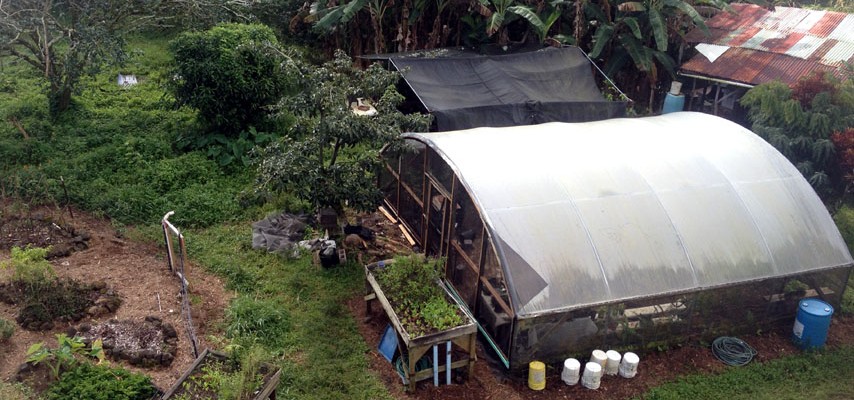
When we first moved to Hawaii and met our neighbors, it wasn’t, “Hi, what’s your name?”, it was more, “Hi, what is your diet?” Diet or what one ate was more important than your name. We met all sorts of people with all sorts of diets–primal, raw, vegan, fruitarian, instinctive, etc. Whole communities were based on diet and they still are. None really seemed to call out to us, until recently. We broke from the traditional once a week grocery store shopping to eating from our own grocery store of sorts–our land.
Always hard to pigeon hole us, we fall into what one might call the localvore diet. We eat things we can get locally especially if it comes from our nine-acre land. Making the transition from store shelves to kitchen garden has been a slow but steady process. Fortunately for us, we have been working in that direction for years and on this farm we have a lot to choose from.
For one, we have a lot of fruit trees–600 to be exact and 80 varieties. We have a screen house where we can grow soft skinned fruits kept protected from the various fruit flies found here. We can grow vegetables like tomatoes, cucumber, summer squash, and watermelon. Just outside our kitchen, is a large garden where we grow broccoli, eggplant, peppers, lettuces, herbs, onions, beans and other vegetables.

Jessica makes banana pie
In addition, we have farm animals: chickens and quails for meat and eggs; goats, sheep, and cows for meat and milk.
Sounds easy doesn’t it?
Generally it is, but there is a huge learning curve. When you start farming from scratch there is no elder or grandparent to show you how it’s done–something me and my farming friends complain about. A missing link to the old school knowledge that used to be past down from generation to generation.
We have to be creative and constantly learning new things. To prepare dinner, we don’t go to the store with a list of ingredients to buy, we see what we have available on the farm and then decide what to make. Some of the staples of our diet are Ulu or breadfruit, pumpkin, squash, cooking bananas, fruit, dairy products, cruciferous vegetables, taro or kalo, yuca, and sweet potatoes.
Breaking from the russet potatoes, onions, cereal, bread, and rice wasn’t easy. In fact, we sometimes do get some of these products if they are organic, but they are not every day or every week.
 Since we’ve made this new leap from limited grocery store to garden, we’ve had the joy of teaching two young adults who came from typical suburbia our new way of eating. They were used to the average American diet and we are showing them how to grow, cultivate, tend and most importantly prepare food from our land. I too am surprised at their progress and their appreciation of it. They like knowing where their food comes from.
Since we’ve made this new leap from limited grocery store to garden, we’ve had the joy of teaching two young adults who came from typical suburbia our new way of eating. They were used to the average American diet and we are showing them how to grow, cultivate, tend and most importantly prepare food from our land. I too am surprised at their progress and their appreciation of it. They like knowing where their food comes from.
Grocery stores have only been around since the 1940s. Before then people were growing their own food, preserving and canning food, building root cellars, milking their own cows, and trading with their neighbors.
If you haven’t joined in, there is a resurgence in America to grow your own food. People are starting to even if they have to grow it in containers on their apartment balcony. What are people finding out? That food tastes much better, there are more choices, food has less chemicals and is more nutritious. They are also finding out that it’s fun, entertaining, and that gardening is good exercise. Next level!
Below is a slide show, showing off some of the dishes we have made mostly from the things growing or being raised from our land. They out shine grocery store food on so many levels. If you’re growing some of your own food, even if it’s just herbs or a fruit tree or two, congratulations and healthy and nutritious eating to you!
and prepare your own foods. This is liberating.
